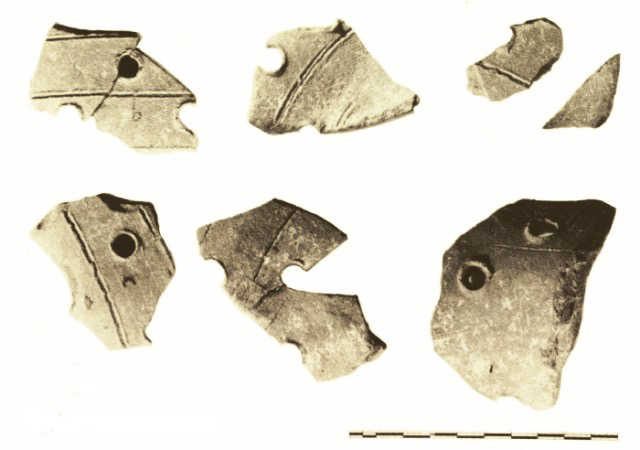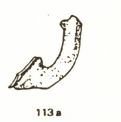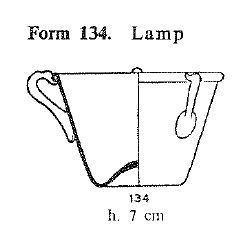Palestinian oil lamp holders
From the table next to sarcophagus 17 and from the quadrangular mound with table related to tombs 20 and 21 of the Columbaris cemetery area you have some pottery fragments (fig. 1) which have been interpreted as Palestinian lamp holders.

Those light orange clay items are three-cone in shape with pitted walls before baking, and opening which the oil lamp goes through. They were found in funerary contexts linked to the refrigerium rite. The assumption is that they held oil lamps of different kinds: the fragment of a glass example (fig. 2) from Cornus, also produced in the east, trunk-conic in shape (fig. 3) is referable to between the IV and V century A.D. That item is easily associated with the lamp holder dated between the IV and VI century A.D.


The fragments have an eastern comparison in three lamp holders found in Palestine (fig. 4) and others found all over the eastern Mediterranean basin, in Syria and Tunisia and in the Italian one of the catacomb of S. Giovanni in Syracuse.

Bibliografia
- B. BAGATTI, Incensieri e portalucerne fittili in Palestina nei secoli II-VII, in Rivista di Archeologia Cristiana, XLVIII, 1-4, 1972, pp. 35-41.
- P. V. CORBO, Gli scavi di Khirbet Siyar el-Gahanam (Campo dei Pastori) e i monasteri dei dintorni = Studium Biblicum Franciscanum, 11, Gerusalemme 1955, p. 81.
- A. M. GIUNTELLA, Contributo allo studio della ceramica d'età tardoantica ed altomedievale della Sardegna, in Atti del V Congresso Nazionale di Archeologia Cristiana (Torino, Valle di Susa, Cuneo, Asti, Valle d'Aosta, Novara, 22-29 settembre 1979), I-II, Roma 1982, II, pp. 635-647.
- A. M. GIUNTELLA (a cura di), Cornus I. 2. L'area cimiteriale orientale. I materiali = Mediterraneo tardoantico e medievale, 13. 2, Oristano 2000, p. 15.
- A. M. GIUNTELLA, G. BORGHETTI, D. STIAFFFINI, Mensae e riti funerari in Sardegna: la testimonianza di Cornus = Meditarraneo Tardoantico e medievale. Scavi e ricerche, 1, Taranto 1985, pp. 78-79, 99, 105.
- C. ISINGS, Roman Glass from dated Finds, Groningen 1957, p. 162.
- H. LECLERCQ, s.v. Coupe, in Dictionaire d'archèologie chrétienne et de la Liturgie, III, coll. 3004-3013.
- L. PANI ERMINI, A. M. GIUNTELLA, Cornus. Indagini nell'area paleocristiana. Relazione preliminare della campagna 1978. Appendice sui materiali ceramici a cura di A. M. GIUNTELLA, in Atti dell'Accademia Nazionale dei Lincei. Notizie degli scavi di antichità 1981 [pubbl. 1982], pp. 541-591.
- A. SERENI, Osservazione sui reperti rinvenuti nell'area cimiteriale orientale di Cornus, in P. G. SPANU (a cura di), con la collaborazione di M. C. OPPO e A. BONINU, Insulae Christi. Il cristianesimo primitivo in Sardegna, Corsica e Baleari = Mediterraneo tardoantico e medievale. Scavi e ricerche 16, Oristano 2002, pp. 253-276.
- D. STIAFFINI, Mensa a ridosso del sarcofago 17, in G. BORGHETTI, D. STIAFFINI, Catalogo. I materiali vitrei, in A. M. GIUNTELLA, G. BORGHETTI, D. STIAFFFINI, Mensae e riti funerari in Sardegna: la testimonianza di Cornus = Meditarraneo Tardoantico e medievale. Scavi e ricerche, 1, Taranto 1985, pp. 109-110.

 VR
VR